Program science: Taking the guesswork out of prevention

For those of us who work in HIV and Hep C prevention, the advent of new prevention approaches has made us increasingly dependent on evidence for making informed decisions about the best strategies to use with a particular client or community.
Program science – the systematic application of scientific knowledge to improve the design, implementation and evaluation of programs – is becoming increasingly important in Canada to help us advance the response to HIV and hepatitis C.
However, it isn’t always easy to decipher the science and translate that into language that our colleagues and clients understand. We may also have to let go of long-held beliefs that may now not necessarily hold true when new science changes the realities of prevention, either through medical advancements or through better understanding of how a virus is transmitted.
Consider serodiscordant couples, where one partner is HIV positive and one is HIV negative. Only 10 years ago, prevention messaging for serodiscordant couples provided very limited options to reduce the risk of HIV transmission from one partner to the other. Today, with additional tools in the prevention toolbox and a better understanding of how viral load affects the risk of HIV transmission, the paradigm is changing – and so are our prevention messages.
Armed with the new knowledge that HIV treatment can also reduce the risk of HIV transmission, public health practitioners have also been able to develop better HIV prevention strategies at a population level. Most recently, UNAIDS used this evidence to change the narrative on global HIV treatment targets – encouraging policy-makers to recognize the prevention benefits of a 90-90-90 strategy: 90% of people with HIV being diagnosed, 90% of those diagnosed being on treatment, and 90% of those on treatment having an undetectable viral load.
Program science can help us reach these targets. In Canada, for example, approximately 25% of HIV-positive people are unaware of their status, with a systematic review showing low uptake of testing even among some populations with high rates of HIV infection. Evidence on different approaches to HIV testing – such as rapid point-of-care testing and testing as part of routine medical care – can help us improve and expand our programming to close these gaps.
Program science can also give us ideas and evidence from around the world to create new programs that don’t currently exist in Canada. Proven international success with interventions such as gay men’s health campaigns, prison-based needle and syringe programs, and a national HIV testing day, can give program developers and policy-makers the evidence they need to secure funding and support to implement these strategies here at home.
Although it can seem daunting, evidence is a valuable tool for everyone involved in HIV and hepatitis C prevention. It can help us choose which programs to implement, help to make them more effective, and garner support from decision-makers who want to see the return on their investments.
As program science becomes more established in Canada, and evidence increasingly becomes an expectation when developing programs, CATIE has scaled up its focus on this area through publications like Prevention in Focus, synthesizing and translating knowledge so that service providers can find the evidence they need to help them develop and evaluate their programs.
Zak Knowles is Web Content Manager at CATIE, where he works on keeping the website up-to-date and is Editor of Prevention in Focus. Before coming to CATIE, Zak worked at Toronto’s Hassle Free Clinic as an HIV Counsellor.
